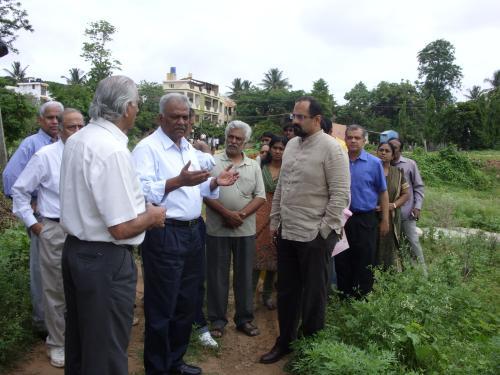It is an 11.2 acre plush green landscape. A few huts have sprouted here and there. Encroachments. Pigs and cows graze along quietly. Apart from the piles of garbage strewn in certain portions, the Meistripalya kere (also known as Jakkasandra Lake) is a vital open space for residents of Koramangala.

Meistripalya kere is a vital open space for residents of Koramangala. Pic: Vaishnavi Vittal.
It is to protect this very lung space that the residents of Koramangala fought for years. Their efforts finally bore fruit in February 2010 after the Supreme Court ruled in their favour to protect this land as an open space. And on Friday, June 18th 2010, the BDA announced to restore the lake and develop a tree park in a portion of the tank area.
At a public meeting held near this tank, located in Koramangala 3rd Block, BDA Commissioner H Siddaiah said the Detailed Project Report (DPR) for the project will be ready in one month’s time. Also present were residents of Koramangala and Rajya Sabha MP and Convenor of the state government’s Agenda for Bengaluru Infrastructure Development (ABIDe) task force, Rajeev Chandrasekhar.
The Supreme Court ruled in February 2010 that the 11.2 acre lake land was state government property. The ruling went against one individual, R Hanumaiah, who claimed rights to be the owner of the land. Residents of Koramangala had been spearheading a legal battle for more than a decade. When the case was in the Karnataka High Court, the Court specified that the tank belongs to the government. But Hanumaiah appealed to the Supreme Court.
Combined effort
Koramangala resident Vijayan Menon, who has been a part of the effort to preserve the tank says, “It feels good that you can win by being persistent. There were many ups and downs. Lot of unexpected things. But we had a devoted legal team. I must give equal, if not more, credit to Laila Oolapally, who worked on the legal side”.
Speaking to Citizen Matters about the residents’ efforts to protect this tank, Commissioner Siddaiah said it wasn’t just the citizens who fought to protect the land, but also the BDA. “Right from the beginning we have been wanting to protect this land. We have succeeded in convincing the Supreme Court. We will develop the lake and a portion of it will be a tree park.”
Rajya Sabha MP Chandrasekhar says, “It is not so much only citizens. BDA has also been committed. It’s a partnership. If you work along with the government, you can get things done.”
At the meeting, Chandrasekhar requested the BDA Commissioner to involve the residents in finalising plans and conduct one public session for inputs. Siddaih agreed to this and told the residents, “Your inputs will be the DPR.”
The Koramangala residents have formed a task force for this purpose, the coordinator of which is Muralidhar Rao, who is also a member of political party Lok Satta. Of the 11.2 acres, only about 9 acres is available because of a telephone exchange. Menon, who is also one of the members of the task force, says that they are consulting a team of experts for technical inputs. “It is not just about wanting a lake. What kind of lake? How do you handle the water flow? These are some of the questions we will address”, Menon says.
This citizens’ team will submit a technical report to the BDA which will also show the network of rajakaluves which will require to be restored to revitalise the lake.
“Revise Master Plan to indicate Meistripalya as open space”
Adjacent to the Meistripalya tank is 6.21 acres of land which is still subjudice. A portion of this land, six plots to be precise, was handed out as sites to MLAs by the state government. There are 47 sites in all, in these six acres. The residents of Koramangala took this case to Court as well, demanding that this portion of land also be preserved as an open space. The Karnataka High Court ordered a stay on the allocation, barring the state government from handing out the remaining 41 sites to legislators. The High Court also ordered the government to allot alternate sites to the legislators, says Koramangala resident Major (Retd) Kapur.
It is through these six acres that the rajakaluves run, joining the 11.2 acre tank-bed area. Siddaiah remained mum about this particular case except saying that the water channels will not be affected in any way. Chandrasekhar said, “The Chief Minister and Bangalore south Lok Sabha MP Ananth Kumar have said they want to restore the network of rajakaluves in the city.”

BDA Commissioner H Siddaiah (second from left) and Rajya Sabha MP Rajeev Chandrasekhar (fourth from left) speaking to Koramangala residents at the Meistripalya tank. Pic: Vaishnavi Vittal
Another concern voiced by the residents at the meeting was about the BDA’s Revised Master Plan (RMP) 2015 indicating that the Meistipalya tank be used as ‘built-up’ area for commercial purposes. The 1995 BDA Master Plan showed this space to be an an open space/tank bed area. This was, however, revised in the RMP 2015. Siddaiah promised the residents saying, “We have initiated steps to change the master plan. We will recommend the necessary changes.”
Siddaiah also said that once work on restoring the tank begins, it will be completed in less than six months time. The cost of the project will be estimated once the DPR is ready, he added. The encroachments on the tank area will also be cleared, he said.
Major Kapur also requested the Commissioner to prepare an inventory of all the open spaces in Koramangala, to which Siddaiah responded in the affirmative.
Chandrasekhar appealed to the residents to work on the project in a sustained basis. “Citizens of the neighbourhood will have to engage with government agencies. This is a classic example. This is a sustainable model for Bangalore. I hope all RWAs (Resident Welfare Associations) adopt this model of partnership.” ⊕